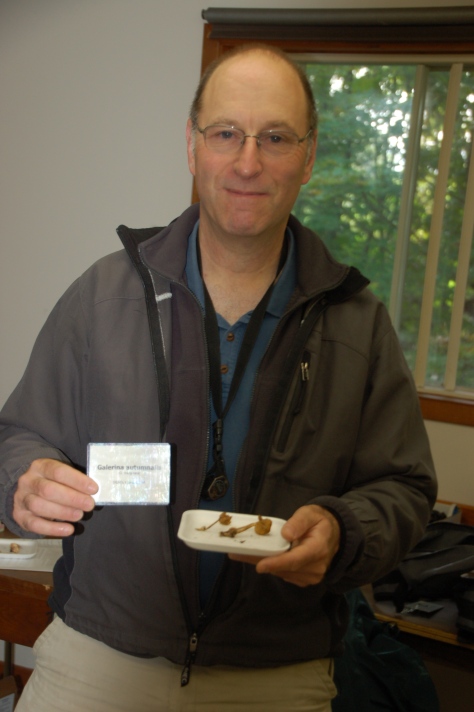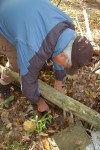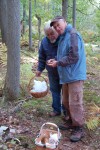Post by Art Goldsmith
![]() On October 1st and 2nd, 2015, I had the unqualified pleasure of joining the inimitable Richard Aaron, who teaches the “Fabulous Fall Fungi” workshops at the Queen’s University Biological Station (QUBS). Right, with a weapon in hand, Richard makes a point to the small class (limited to twelve people). Unlike previous field courses that I have covered for this blog that are intended for undergraduate university students, this one is open to anyone who is interested. It is a three-day workshop that was offered three times in 2015. Several participants have taken the workshop several times, as it provides the ideal blend of learning and invigorating outdoor activity. As extra enticement, no two workshops yield the same set of species. If luck prevails, a carefully selected specimen may be cooked for lunch! Before attempting this on your own (eating a specimen for lunch), take the workshop at least once.
On October 1st and 2nd, 2015, I had the unqualified pleasure of joining the inimitable Richard Aaron, who teaches the “Fabulous Fall Fungi” workshops at the Queen’s University Biological Station (QUBS). Right, with a weapon in hand, Richard makes a point to the small class (limited to twelve people). Unlike previous field courses that I have covered for this blog that are intended for undergraduate university students, this one is open to anyone who is interested. It is a three-day workshop that was offered three times in 2015. Several participants have taken the workshop several times, as it provides the ideal blend of learning and invigorating outdoor activity. As extra enticement, no two workshops yield the same set of species. If luck prevails, a carefully selected specimen may be cooked for lunch! Before attempting this on your own (eating a specimen for lunch), take the workshop at least once.
I arrived on the afternoon of the second day of the workshop. Collecting and identifying had occurred the entire day before. Both identified and yet-to-be identified specimens were spread across the tables, with Richard sharing salient tidbits about the various fungi with the class.
The Real Reason for the Knife
Richard had just cut the mushroom shown below in half lengthwise. As you can see, the yellow flesh almost instantly turned blue when exposed to the air. This bolete mushroom (a bolete has pores on the underside of its cap rather than gills) is called Boletus subvelutipes, which grows on the ground under hardwoods, especially oak, and conifers, particularly hemlock.
Above is a Chanterelle (Cantharellus cibarius), the same kind served in fancy restaurants. Those wrinkles look like gills, but they aren’t!
Above is a Hexagonal-Pored Polypore (Favolus alveolaris), which grows on dead branches and is usually seen only after the branches fall to the ground.
Above, one of the most common and most recognized polypore mushrooms, Turkey Tail, found on forest floor logs. Unlike many other common names, this one is descriptive. There are other bracket fungi (polypores) which look like Turkey Tail. There’s even a fungus without pores called False Turkey Tail which that bears a striking resemblance.
Above, Richard explains a central characteristic for identifying gilled mushrooms: how the gills (lamellae) attach or do not attach to the stem. The latter arrangement shown by Richard above, is termed “free gills” because the gills are not attached to the stem. And if the attachment is more narrow, this is called “adnexed”, whereas “decurrent” gills attach at a downward angle along the stem, forming an angular whorl around the stem. The other two gill attachments Richard discussed were “notched” and “sinuate”, both of which are notched along each gill edge close to the stem.
Above, Polyporus squamosus, a Basidiomycete commonly known as Dryad’s Saddle, which grows on hardwood stumps, logs and trees. It is an annual bracket fungus, with the characteristic colours, flattened scales and black stem as seen in the photo of this mature specimen (immature specimens lack the black stem). Polypores, as their names suggests, have pores on the underside, which are the openings of tubes. The pores of some species can be seen with the naked eye, whereas other species require the use of a hand lens.
There are an estimated 5,000 macrofungi in Ontario (fungi that can be seen with the naked eye). Field guides don’t cover most of these. For example, Mushrooms of Ontario and Eastern Canada covers just over 600 species. Right, workshop participant Brett, who was a great help to me and others, as he has taken the workshop before, was identifying the following mushroom, with a partial veil, rosy-coloured cap and yellow flesh: a Suillus pictus (sometimes referred to as Suillus spraguei), which is found under White Pine trees.
![]()
We’ll get back to Brett later, as he provided a photo of a magical fungal phenomenon from the local woods.
Above is one of the “inky cap” mushrooms, which belongs to the order Agaricales (gilled mushrooms). It is a decomposer of wood, and can be found on wood chips, sawdust, and other woody debris. As this mushroom ages, the gills liquefy into a black inky mess, and the cap quickly changes from a bell shape to a split flat cap like the one shown above. This transformation aids in the distribution of spores, although making the species at this stage more difficult to identify. The one above was identified as Coprinus lagopus. Recent DNA studies suggest different evolutionary relationships, and it is now known as Coprinopsis lagopus, but Richard chose to use the name found in field guides in order to avoid confusion.
Above is a very special mushroom, Panellus stipticus, which is also featured below, doing its magical thing, bioluminescence. Yes, if you are a good mushroom detective, and find a colony of this mushroom during the day, go back at night to see the show. Thanks to Brett for taking this photo, and to Richard for sending it to me.
One peculiar characteristic sometimes used as aid in identifying fungi is odour. It so happens that a small percentage of fungi have distinct odours, reminiscent of coconut, anise, maple syrup, almond extract, coal tar, mouse, radish, cucumber, flour and more. Jennifer is seen below taking a close look at one of these, a Lobster Mushroom (Hypomyces lactifluorum), which she had collected. This unique species does indeed smell much like fresh lobster. It also has a different lifestyle, as it feeds on other mushrooms. Technically, this is not a mushroom, but a parasitic ascomycete fungus.
Fungi grow everywhere. They are a universal life form, making up a large proportion of the Earth’s living mass. Below is a gilled mushroom that grows on conifer cones, particularly white pine and Norway spruce, and also on magnolia cones: Baeospora myosura. The convex shaped cap is crowned with a papilla (literally, a nipple), a characteristic shared with many small, gilled mushrooms, particularly in the genus Inocybe.
After supper, we waited until sundown and then gathered in the lab. Once we were all seated in one corner of the lab, we gathered the sticks that hosted the Panellus stipticus. The lights were then turned off, and our eyes slowly adjusted to the dark. After a few minutes the Panellus stipticus was passed from person to person so we could see the light show (as shown in Brett’s photo above) close up. I must say this was a moving and mystical experience, one of the highlights of a glorious summer.
Afterwards, we went to the seminar room, where Richard played Taylor Lockwood’s tantalizing film, Spirits of the Forest, about his (Taylor’s) global search for as many species of bioluminescent mushrooms as he could find. It capped the perfect day.
You may find more about Taylor Lockwood, his film and his quest here.
The collecting continued the next day. Richard wrote to me to say that by the end of the workshop, 161 species had been identified. This is just shy of the record 165 species found in one of the 2014 workshops. Of the 161 species, 33 had not been found in any of the previous workshops.
I followed the participants out on Cow Island as they collected. Here, Karl is seen collecting two mushrooms for his basket. Ekky (short for Ekkehard) joined us to take a look. Their first guess, which proved to be correct, was that these were Boletus edulis, which is a great find (as this species is a choice edible).
As we left the trail, I took the above photo of a most impressive Northern Tooth Fungus, Climacodon septentrionalis. The Latin name translates as “Northern stair tooth”, alluding to the teeth on its underside, its staircase pattern of growth, and occurrence in the northern hemisphere. It forms massive (35 cm. high and 25 cm. wide is not unusual) clusters each year on wounds of standing hardwood trunks, especially maple.
We reached the Raleigh J. Robertson Biodiversity Centre in time for lunch, which included some especially tasty Oyster Mushrooms we had collected, along with several other species (Richard emailed to say that the class sampled five different species over the three days of the workshop). After lunch, I bid my adieus to Richard and his students. Thanks, Richard for an especially illuminating time. We will see you next Fall at QUBS!



